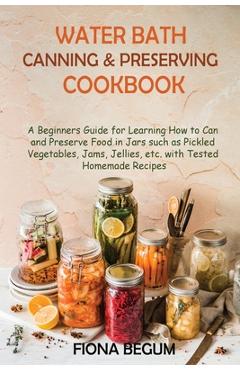Water Bath Canning and Preserving Cookbook: A Beginners Guide for Learning How to Can and Preserve Food in Jars such as Pickled Vegetables, Jams, Jell - Fiona Begum

Detalii Water Bath Canning and Preserving
Vânzător
libris.ro
Pret
117.13 Lei
117.13 Lei
130.14 Lei
Categorie (vânzător)
Cooking
Marca
Fiona Begum
Descriere YEO:
Descriere magazin:
A Guide To Using The Water Bath Canning Method To Freshly Preserve Pickled Vegetables, Jams, Jellies, and More High acid foods are processed using the water bath canning method. If done correctly, it will enable you to preserve fruit, juices, jams, jellies, and pickles on a pantry shelf at room temperature without spoiling. Water bath canning has been used for food preservation for many years. Its original purpose was to preserve food for the armed forces. After becoming accustomed to eating canned food, soldiers continued to do so after returning home. Even now, people are being urged by the government to can their own food, as it was during WWII. You can bet that our grandparents all preserved their own food in cans. However, due to the ease with which canned foods are now accessible, we have mostly forgotten how to properly employ water bath canning (alongside the many skills our grandparents knew). Nonetheless, all hope is not lost. Many people are picking up the skill of canning in order to become more self-sufficient. Canning in a water bath is fantastic. The simplest way to learn how to can, in my opinion, is with a water bath canner. Even if you have to purchase your canner brand-new and are unable to find one for $1 at a yard sale, it is less daunting than pressure canning and has a lower startup cost.If you are looking for a simplified guide on how to get started with water bath canning as a beginner, then this book is for you. Below are snippets of what you will learn; Foods that should be canned using the water bath methodFoods unsafe to can at allRules for safely canning your foods in a water bath cannerImportant tools required to preserve your food in a water bath cannerCommon water bath canning mistakes and how to avoid themWater bath canning FAQs and answers that address common home canning concernsTested and safe recipe instructions for pickled vegetables, such as asparagus, beets, dilled beans, Jerusalem artichoke, etc.Tested and safe recipe instructions for tomatoes, sauces, and salsas, such as Italian-style tomato sauce, harissa sauce, tomatillo salsa, etc.Tested and safe recipe instructions for jams, jellies, and marmalades, such as apricot jam, pomegranate jelly, apple marmalade, etc.Tested and safe recipe instructions for relishes and chutneys, such as piccalilli relish, cranberry-orange Chutney, etc. And many more! So what more are you waiting for? Get a copy of this book RIGHT NOW to get started.

Water Bath Canning and Preserving - Disponibil la libris.ro
Pe YEO găsești Water Bath Canning and Preserving de la Fiona Begum, în categoria Cooking.
Indiferent de nevoile tale, Water Bath Canning and Preserving Cookbook: A Beginners Guide for Learning How to Can and Preserve Food in Jars such as Pickled Vegetables, Jams, Jell - Fiona Begum din categoria Cooking îți poate aduce un echilibru perfect între calitate și preț, cu avantaje practice și moderne.
Preț: 117.13 Lei
Caracteristicile produsului Water Bath Canning and Preserving
Comandă Water Bath Canning and Preserving Online, Simplu și Rapid
Prin intermediul platformei YEO, poți comanda Water Bath Canning and Preserving de la libris.ro rapid și în siguranță. Bucură-te de o experiență de cumpărături online optimizată și descoperă cele mai bune oferte actualizate constant.
Descriere magazin:
A Guide To Using The Water Bath Canning Method To Freshly Preserve Pickled Vegetables, Jams, Jellies, and More High acid foods are processed using the water bath canning method. If done correctly, it will enable you to preserve fruit, juices, jams, jellies, and pickles on a pantry shelf at room temperature without spoiling. Water bath canning has been used for food preservation for many years. Its original purpose was to preserve food for the armed forces. After becoming accustomed to eating canned food, soldiers continued to do so after returning home. Even now, people are being urged by the government to can their own food, as it was during WWII. You can bet that our grandparents all preserved their own food in cans. However, due to the ease with which canned foods are now accessible, we have mostly forgotten how to properly employ water bath canning (alongside the many skills our grandparents knew). Nonetheless, all hope is not lost. Many people are picking up the skill of canning in order to become more self-sufficient. Canning in a water bath is fantastic. The simplest way to learn how to can, in my opinion, is with a water bath canner. Even if you have to purchase your canner brand-new and are unable to find one for $1 at a yard sale, it is less daunting than pressure canning and has a lower startup cost.If you are looking for a simplified guide on how to get started with water bath canning as a beginner, then this book is for you. Below are snippets of what you will learn; Foods that should be canned using the water bath methodFoods unsafe to can at allRules for safely canning your foods in a water bath cannerImportant tools required to preserve your food in a water bath cannerCommon water bath canning mistakes and how to avoid themWater bath canning FAQs and answers that address common home canning concernsTested and safe recipe instructions for pickled vegetables, such as asparagus, beets, dilled beans, Jerusalem artichoke, etc.Tested and safe recipe instructions for tomatoes, sauces, and salsas, such as Italian-style tomato sauce, harissa sauce, tomatillo salsa, etc.Tested and safe recipe instructions for jams, jellies, and marmalades, such as apricot jam, pomegranate jelly, apple marmalade, etc.Tested and safe recipe instructions for relishes and chutneys, such as piccalilli relish, cranberry-orange Chutney, etc. And many more! So what more are you waiting for? Get a copy of this book RIGHT NOW to get started.

